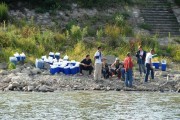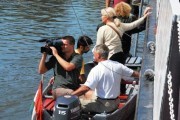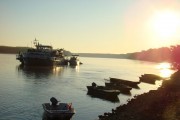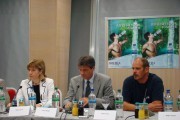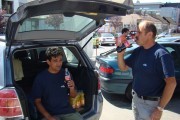
Entering Croatia meant leaving the EU and its five EU Upper and Middle Danube countries - Germany, Austria, Slovakia, Czech Republic and Hungary. It also led to a happy reunion with the JDS2 driver who had taken an emergency run to Bratislava and back to get replacements for the sediment sampling sieves that had broken the night before (See Diary Aug.31).
The team was also soon welcomed by: Zeljko Ostojic, Head of Division at the Croatian Ministry of Agriculture, Forestry and Water Management and Head of Croatia's delegation to the ICPDR; ICPDR Executive Secretary Philip Weller; representatives from Croatian Waters (Hrvatske Voda); and the Croatian National Team of scientists. Mr. Ostojic then invited the visitors to a local restaurant for fish soup (a major competitor for Hungary´s fish soup) and planning for the next day's press conference in the city of Osijek on the Drava River. Also that night, the three JDS2 ships were forced to anchor in the Aljmas Marsh some 20 km from shore given the low waters of the Drava.
Press conference, Osijek
Early Sunday morning (September 2), three team members left the ship for shore and car to get to the 09:00 press conference at the Hotel Osijek. The press conference, headlined by Mrs. Ruzica Drmic, Assistant to the Minister of Agriculture, Forestry and Water Management, attracted many journalists including a crew for the nation's biggest TV station.
During the presentations, JDS2 Team Leader Bela Csanyi noted the significant impacts that large cities such as Budapest have on the Danube downstream, and that Budapest was taking the right steps in building a massive new sewage treatment plant to help improve the situation. He added that, crossing from the EU to Croatia, there was no recognizable border on the river itself, signifying the need for multinational cooperation to improve the Danube environment
A return to the ships was followed by sampling demonstrations for the journalists, some of which interviewed Zoran Durokovic, Director of Croatia's Water Management Department for the Drava and Danube River Basin. The ICPDR's Philip Weller got into the Drava mud onshore for some discussions with the scientists at work. With the reappearance of the new sampling sieves, many team members busily caught up on their work to isolate the sediment required for chemical analyses from the last few sampling stations. Everyone was also happy to see the bottles unloaded for the ships from a truck of the Coca-Cola Hellenic Bottling Company, a key private supporter of the JDS2.
Regular sampling earnestly continued afterwards. Given the late departure of the media, it was a big achievement to still complete Sites 41 (Upstream Drava) and 42 (Drava) by day's end, with the Croatian National Team helping out with the work on the Drava River. And on Sunday night, Philip Weller, Ruzica Drmic and Zoran Durokovic had the opportunity to discuss future possibilities for cooperation between the Croatian government and ICPDR, including a press event in 2008 to present the results of the JDS2 efforts Croatia-wide.














